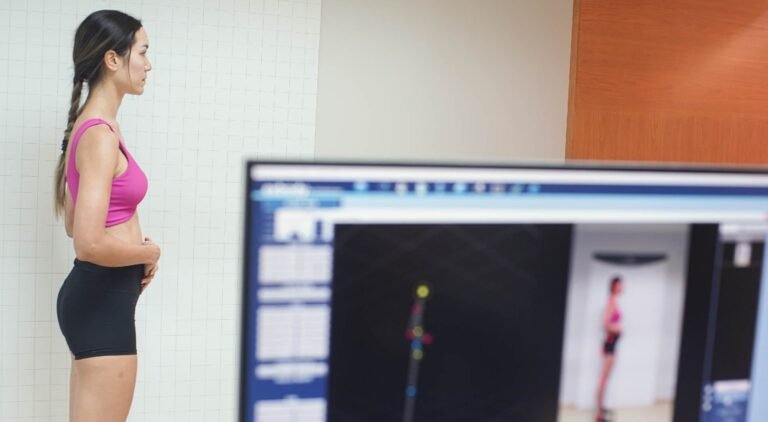Understanding herniated disk diagnosis and management can seem overwhelming. This guide aims to help you navigate this complex area. It covers the causes, risk factors, and the latest in diagnosis and treatment. We’ll explore the world of spinal health in depth.
If you’re experiencing back pain, tingling, or mobility issues, this guide is for you. We’ll share the latest in spinal imaging, non-surgical and surgical treatments, and rehabilitation. Our goal is to help you take charge of your recovery and live pain-free.
We’ll also focus on preventive measures and lifestyle changes. This includes ergonomic tips and exercise routines. By tackling the root causes and being proactive, you can lower your risk of future problems and boost your health.

As we explore this journey, we’ll introduce you to the Greenbell Physiotherapy Clinic in Bangkok. Their team is dedicated to providing personalized, evidence-based care. They’re here to help individuals like you find relief and achieve optimal spinal health.
Key Takeaways
- Gain a comprehensive understanding of herniated disk diagnosis and management strategies.
- Explore the latest advancements in spinal imaging techniques, non-surgical treatments, and surgical interventions.
- Discover effective pain management strategies and rehabilitation exercises to support your recovery.
- Learn about the risk factors and preventive measures to reduce the likelihood of herniated disk-related issues.
- Discover the specialized care and expertise offered by the Greenbell Physiotherapy Clinic in Bangkok.
Understanding Herniated Disks
Herniated disks, also known as ruptured or slipped disks, are a common spinal health issue. They can cause a lot of discomfort and make it hard to move. Knowing what causes them and who is at risk is key to managing and preventing them.
Causes and Risk Factors
Herniated disks often happen as we age. Over time, the disks in our spine wear down. This can cause cracks or tears, letting the soft center bulge out and press on nerves. Factors that can increase the risk of developing a herniated disk include:
- Age: The risk goes up after 30.
- Injury or trauma: A sudden impact, like from a fall, can cause a herniated disk.
- Repetitive heavy lifting or twisting: Jobs that strain the back can lead to disk problems.
- Obesity: Being overweight adds stress to the spine, raising the risk of disk issues.
Symptoms and Signs
The main symptoms of a herniated disk are pain, numbness, tingling, and weakness in the affected area. These symptoms can spread down the arms or legs. The exact symptoms depend on where the disk is herniated and which nerves are affected. Some individuals may also experience:
- Severe or sharp pain in the back, neck, or extremities
- Muscle weakness or loss of sensation in the affected limb
- Difficulty walking or maintaining balance
- Bowel or bladder dysfunction in severe cases
Getting a quick diagnosis and treatment for herniated disks is important. It helps prevent more problems and keeps the spine healthy.
Diagnostic Procedures for Herniated Disks
Figuring out if you have a herniated disk is key to finding the right treatment. Doctors use a detailed physical check-up and special imaging to do this.
Physical Examination
Doctors will check how well you move, your muscle strength, and reflexes during the physical exam. They might also do tests like the straight leg raise test. This helps them see if nerves are being pinched by the herniated disk.

Imaging Tests
Doctors also use imaging to make sure they’ve found the right problem. They might use:
- X-rays: These show the spine’s basic structure and alignment.
- Magnetic Resonance Imaging (MRI): This gives detailed pictures of the spinal cord and disks, showing where the herniation is.
- Computed Tomography (CT) Scans: These scans show the spine’s cross-section, helping to see how bad the herniation is.
By looking at what the physical exam and imaging tests show, doctors can pinpoint a herniated disk. Then, they can create a treatment plan that fits your needs.
Non-Surgical Treatment Options
For those with a herniated disk, non-surgical treatments offer pain relief and support healing. These methods are often the first choice. They aim to fix spinal health issues without the risks of surgery.
Pain Management Strategies
Managing a herniated disk’s pain is key. Several non-surgical treatments can help:
- Medication: Anti-inflammatory drugs or pain relievers can ease discomfort.
- Physical Therapy: Exercises and manual techniques by a physical therapist can improve flexibility and strength.
- Alternative Therapies: Acupuncture, chiropractic adjustment, and massage therapy offer more non-surgical herniated disk treatments.
Using a mix of these non-surgical herniated disk treatments can lead to pain relief. It also supports spinal health without surgery.
“The key is to work closely with a healthcare provider to develop a tailored treatment plan that addresses the specific needs and goals of the individual.”
At Greenbell Physiotherapy Clinic in Bangkok, our team offers comprehensive non-surgical herniated disk treatments. We help patients improve their quality of life and spinal health.
Surgical Interventions for Herniated Disks
For those with herniated disks who haven’t seen improvement with other treatments, surgery might be needed. These surgeries aim to fix the problem and ease pain and symptoms. The main surgical options for herniated disks are:
- Discectomy: This common surgery removes the damaged disk part to ease nerve pressure.
- Laminectomy: This involves removing a small bone part to make room for the nerve and reduce pressure.
- Spinal Fusion: This method fuses vertebrae together to stabilize the spine and prevent further issues.
The right surgery depends on the disk’s severity, location, and the patient’s health. After surgery, patients need physical therapy to regain strength and mobility.
| Surgical Procedure | Description | Potential Benefits | Potential Risks |
|---|---|---|---|
| Discectomy | Removal of the damaged or protruding portion of the disk | Immediate relief of nerve compression, improved mobility | Risk of infection, nerve damage, recurrent disk herniation |
| Laminectomy | Removal of a small portion of the vertebral bone | Increased space for the affected nerve, reduced compression | Risk of instability, infection, nerve damage |
| Spinal Fusion | Fusing two or more vertebrae together | Stabilization of the spine, prevention of further disk issues | Risk of failed fusion, adjacent segment disease, limited mobility |
People with herniated disks should talk to their doctors to find the best surgery for them. The spinal procedures at the Greenbell Physiotherapy Clinic in Bangkok offer tailored treatment plans for the best results.
Herniated Disk Diagnosis Management
Diagnosing and managing a herniated disk needs a detailed plan. This plan uses different tools and treatments. Knowing the causes, symptoms, and treatments helps people work with their doctors. Together, they can make a plan to fix spinal health and lessen disk problems.
Comprehensive Diagnostic Process
The first step is a detailed physical check-up and looking at medical history. Imaging tests like X-rays, MRI, or CT scans are also used. These help doctors find where and how bad the disk herniation is, and if nerves or the spinal cord are affected.
Multidisciplinary Treatment Approach
After finding out about the herniated disk, a detailed plan is needed. This plan might include physical therapy, pain management, and changes in lifestyle. In some cases, surgery is needed. Greenbell Physiotherapy Clinic in Bangkok uses a team approach. They focus on both the physical and overall health of the patient.

| Diagnostic Procedure | Purpose |
|---|---|
| Physical Examination | Checks muscle strength, reflexes, and movement to find the disk problem. |
| Imaging Tests | Uses X-rays, MRI, or CT scans to see the spinal area and how bad the herniation is. |
By using a detailed check-up and a wide range of treatments, people with herniated disks can get better. They can improve their spinal health and life quality.
Rehabilitation and Exercise Programs
Managing a herniated disk requires a solid rehabilitation plan. After diagnosis and initial treatment, a good exercise program is key. It strengthens the core, boosts flexibility, and aids in recovery. At the Greenbell Physiotherapy Clinic in Bangkok, our experts create personalized exercise plans for each patient.
Strengthening Exercises
To keep the spine stable and support the disk, we suggest specific exercises. These include:
- Planks and side planks to engage the abdominal and back muscles
- Bridges and hip thrusts to strengthen the glutes and hamstrings
- Birddog exercises to challenge the core and improve balance
- Resistance band exercises to target the smaller stabilizing muscles
Stretching and Flexibility Routines
Flexibility and mobility are also crucial for herniated disk recovery. Our physiotherapists lead patients through stretches and drills. These help improve spinal movement and reduce tension. Some examples are:
- Gentle spine rotations and extensions
- Hamstring and hip flexor stretches
- Neck and shoulder releases
- Cat-cow poses to mobilize the spine
Our programs at the Greenbell Physiotherapy Clinic in Bangkok combine strengthening and flexibility. This approach aids in herniated disk rehabilitation, enhances spinal health, and helps manage the condition over time.
| Exercise | Benefits | Targeted Muscles |
|---|---|---|
| Planks | Improve core stability and strength | Abdominals, back muscles |
| Bridges | Strengthen glutes and hamstrings | Glutes, hamstrings |
| Spine rotations | Increase spinal mobility and range of motion | Paraspinal muscles |
| Hamstring stretches | Improve flexibility and reduce tension | Hamstrings |
“A comprehensive rehabilitation program, tailored to the individual, is essential for the long-term management of herniated disk conditions.”
Minimally Invasive Procedures for Herniated Disks
When traditional treatments for herniated disks don’t work, new methods can help. Peripheral magnetic stimulation (PMS) is a non-invasive way to ease pain and aid healing. It doesn’t require big surgeries.
Peripheral Magnetic Stimulation
PMS uses magnetic fields to target nerves and tissues near the spinal area. It’s a gentle method that aims to reduce swelling and ease pressure on the disk. This helps the body heal naturally.
The advantages of PMS for herniated disk care include:
- It’s a minimally invasive treatment.
- Recovery time is shorter than with surgery.
- It might avoid the risks of more invasive methods.
- It can improve spinal health and manage pain better.

This innovative technique can tackle the herniated disk’s root cause. Patients might find lasting relief and better spinal health.
| Procedure | Description | Key Benefits |
|---|---|---|
| Peripheral Magnetic Stimulation (PMS) | Non-invasive treatment using targeted magnetic fields to stimulate nerves and tissues around the affected spinal region |
|
“Peripheral magnetic stimulation offers a promising solution for individuals seeking minimally invasive relief from herniated disk-related pain and discomfort.”
PMS can be a key part of a full spinal health plan. It helps manage herniated disks, leading to long-term comfort and better life quality.
Preventive Measures and Lifestyle Modifications
Keeping your spine healthy is key to avoiding herniated disks. By taking proactive steps and making lifestyle changes, you can protect your spine. This helps prevent problems and keeps your back strong.
Ergonomic Considerations
Good ergonomics are essential for a healthy spine. Make sure your workspace is set up for comfort and support. This means adjusting your desk height, choosing an ergonomic chair, and placing your computer screen right in front of you.
- Invest in a high-quality, adjustable office chair that promotes good posture.
- Position your computer monitor at eye level to avoid neck strain.
- Take regular breaks to stretch and move throughout the day.
Adding physical activity and exercise to your day also helps your spine. Try low-impact activities like walking, swimming, or yoga. These exercises strengthen your core, improve flexibility, and lower herniated disk risk.
| Exercise | Benefits for Spinal Health |
|---|---|
| Walking | Improves posture, strengthens core muscles, and promotes overall cardiovascular health. |
| Swimming | Provides a low-impact workout that strengthens the back and abdominal muscles without putting excessive stress on the spine. |
| Yoga | Enhances flexibility, improves core strength, and promotes better spinal alignment through a range of postures and stretches. |
By following these tips, you can play a big role in keeping your spine healthy. This reduces the chance of herniated disks. Talking to a physiotherapist or doctor can help you find the best plan for your needs.
Greenbell Physiotherapy Clinic Bangkok
In Bangkok, Thailand, the Greenbell Physiotherapy Clinic is a top choice for herniated disk and spinal health care. It has a team of skilled physiotherapists. They offer personalized treatment plans in a caring environment.
The clinic focuses on exceptional care for each patient. It has a team of physiotherapists, chiropractors, and sports medicine specialists. They work together for a complete herniated disk physiotherapy and spinal injury treatment approach.
The clinic uses the latest technology for diagnosis and treatment. This allows for accurate injury assessment and personalized rehab plans. They use exercises, manual therapy, and advanced modalities like electrotherapy and ultrasound. Their goal is to reduce pain, improve function, and aid in long-term healing.
| Services Offered | Specialties |
|---|---|
|
|
The Greenbell Physiotherapy Clinic is known for its excellence. Its team works hard to help patients move better, feel less pain, and live better lives. They focus on evidence-based care and personalized attention. This has made them a top provider of herniated disk physiotherapy and spinal injury treatment in Bangkok.
Conclusion
This guide has covered the key points of herniated disk diagnosis and management. It shows how important a complete approach is for good spinal health. We looked at the causes, risk factors, diagnostic methods, and treatment options.
It’s important to work with healthcare experts, like Greenbell Physiotherapy Clinic in Bangkok, Thailand. They can help you manage your herniated disk. With their help, you can create a treatment plan that works for you.
Managing herniated disks requires a mix of medical care, exercises, and lifestyle changes. This approach helps reduce the condition’s effects and lowers the chance of it coming back. Taking care of your spine is crucial. With the right help, you can start feeling better and living a healthier life.





